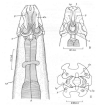|
Females:
- Larger than the male.
- Tail short, conically pointed or blunt, and dorsally curved
- Vulva close to posterior end of esophagus. The vagina is long,
narrow and muscular, and runs straight backwards with the exception of a
U-shaped bend close to the vulva\.
- Didelphic, The two uterine branches are parallel, runningn first
posetriorly then one turning anteriorly, the other continuing
posteriorly. T
- Apparenly, the uterus containing immense numbers of embryos which
are not enclosed in a hard egg-shell.
Males:
- Tail coiled ventrally into a spiral, with lateral alar expansions,
- Spicules unequal, the slender left spicule being from two to four
times as long as the stouter right.,
- Paired caudal papillae with long nerve pulps, in six pairs, of which
four are preanal and two postanal.
- In addition to the paired papillae, a large median double
papilla is present immediately in front of the cloacal aperture
Ref: Baylis, 1921
|

Parabronema indicum. A: Anterior, dorsal; B: Anterior lateral. C:
Face-view, head.
a.a auricular appendage, c.p cervical papilla, d.s dorsal shield, l: lip,
l.p: lateral papilla, p.p: papillae of dorsal and bentral cuticular shields,
s.l.p.: sublateral papilla of lip.
Drawings from Baylis, 1921 |